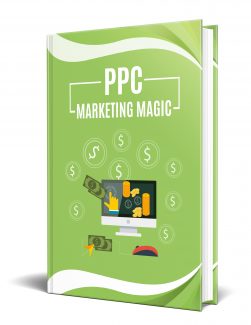
 License Type: Private Label Rights
License Type: Private Label Rights  File Type: ZIP
File Type: ZIP
 SKU: 64130
SKU: 64130  Shipping: Online Download
Shipping: Online Download
Sample Content Preview
INTRODUCTION
PPC, which stands for Pay Per Click marketing has been in existence for many years now, with one of the more popular PPC marketplaces being Google's advertising program, Adwords.
If you aren't familiar with Google Adwords, it's very easy to understand and if you use the Google search engine for personal searches, you are already familiar with the marketplace layout.
Visit http://www.Google.com/ and enter in a keyword string (any keywords under the sun, for example: Coffee Beans)
Adwords ads are the results that appear under the "Sponsored Listings" on the right hand side of the search results window, as well as the ones that are highlighted above the search results.
Take a look at the image below to see the ad blocks highlighted in red.
This is where your advertisements could appear once they are live via the Adwords network.
These are advertisements that PPC marketers using the Adwords system have created. They appear in block format and feature an ad title, two lines of ad copy, and a link that directs readers to their landing page.
Advertisers can create as many advertising blocks (and campaigns) as they wish and by bidding on keywords, their advertisements will appear within different positions.
So, how can an average joe marketer join the ranks of successful PPC gurus who have utilized the popularity of PPC search engines and marketplaces to jump start websites, establish an online presence, build a brand, grow a list and maximize their income potential?
If that’s your motto, you’re ready to jump right into this guide, with our first chapter being focused on the Google Search Network, a powerful tool that will send unlimited traffic to your website in a matter of a few minutes.
Let’s begin!
CHAPTER 1:
INTRODUCTION TO GOOGLE SEARCH NETWORK
Showcasing your advertisements within the Google Network can significantly increase your marketing exposure to customers, especially when you consider the fact that your ads will be eligible to show up on thousands of search and content sites and products, in addition to Google search results pages.
But what, exactly, is the Google Network?
It is made up of two areas - the Google Search Network and the Google Content Network. As an advertiser, you may select whether your ads will be visible on either or both of these networks.
The Google Search Network continues to be the industry leader, as evidenced by the fact that 76.7 billion searches were performed on Google in July 2009, which was an increase of 58 percent compared to the same month in the previous year.
What does this mean for your business?
It means you have an incredible opportunity before you!
Google Search
The majority of your traffic that will convert into sales should come from Google Search.
This refers to the ads that appear on the results pages when your potential customers are using the search engine, including Google search pages, properties that display search results pages such as Google Product Search and Earthlink.
The easiest way to think of this is when you sit down at Google.com, type a phrase in the search box, and then receive the results.
If you would like to tap into the mind of your target customers, think in these terms. The people who will find your ads through Google Search are actively seeking a solution to a problem.
That is why they have turned to a search engine - to find an answer to that particular problem. You have a greater chance of getting their business if you provide an answer to the solution they seek.
Google Global Search
The vast Google Global Search has the power to supply your business with an amazing reach, since it provides web sites and portals with access to 3 billion web pages and the world's most sophisticated search technology.
Revenue opportunities through Google partner sites are made available with sponsored links from Google's worldwide network of advertisers. These Google partner websites include many of the largest web sites in the world such as AOL, Ask, Earthlink, Google Maps, Google Product Search, and Google Groups.
Your ad can appear within dozens of external networks including Earthlink, Ask Jeeves, America Online and even Compuserve.
Your ads may appear above or to the side of the search results, on the results page as a user finds their way through a web site's directory, or on other relevant search pages.
Google Content Network
By choosing the Google Content Network, your adds will be display on websites instead of the alongside Google search engine results.
Think of the Google Content Network as an enormous group of web sites with the common bond of hosting AdSense as a way for the sites to bring in revenue.
This can be good or bad. It can be good because there are some quality sites out there, which will increase your exposure.
It can be bad as there are websites created with the sole purpose of encouraging visitors to click on your ads so the web site owner can make money (essentially, costing you money for invalid clicks).
Google actively monitors these situations, with an eye out for click fraud detection, and bans sites when deception is suspected.
The Google Content Network includes news pages, topic-specific websites, blogs, and other sites where visitors are actively engaged with content, as opposed to merely conducting searches. Your ads might appear if a web site’s content and URL correspond with the keywords in the campaign.
Content Network partners include About.com, Lycos.com, NYTimes.com, InfoSpace.com, ReedBusiness.com, HowStuffWorks.com, Business.com, FoodNetwork.com and HGTV.com.
Users of Gmail may also see your ads within their email accounts.
The people who find your ads on the content network are more likely to be readers, as opposed to the users of Google Search being more likely to be searchers.
While searchers are actively looking for the solution to a problem, readers are often more leisurely about the interpretation and understanding of the actual content. This means that the searcher is more likely to click, while the reader is more likely to continue reading.
- License: Private Label Rights
- Category:Ebooks
- Tags:2021 Ebooks Private Label Rights







